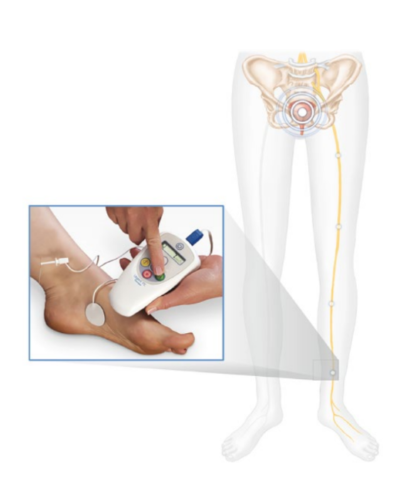Percutaneous Tibial Nerve Stimulation (PTNS)
Percutaneous tibial nerve stimulation (PTNS) at a glance
- PTNS is a nonsurgical treatment for overactive bladder.
- This treatment is delivered by a slim needle that is placed in the ankle where the tibial nerve is located. When the tibial nerve is stimulated, impulses travel to the nerve roots in the spine to block abnormal signals from the bladder and prevent bladder spasms.
- No major side effects have been reported with PTNS. Patients typically describe the sensation during treatment as pulsing or tingling in the foot.
- PTNS requires the patient to commit to 12 weekly doctor visits at the beginning, then monthly treatment afterward to sustain improvements.
What is PTNS?
Percutaneous tibial nerve stimulation is a nonsurgical treatment option for urinary urgency, frequency and urgency incontinence, which is commonly known as overactive bladder (OAB).
Overactive bladder, is a condition that affects millions of people worldwide. It is more common in women but can also occur in men. Symptoms of OAB include the sudden and strong need to urinate, frequent urination, getting up at night to urinate and not making it to the bathroom before leakage of urine occurs.
PTNS is derived from acupuncture in Chinese traditional medicine. In 2011 the Food and Drug Administration approved PTNS as a treatment option for OAB. Many research studies have looked into the effectiveness of it and found success rates between 50 and 80 percent.
Achieve relief. Contact us today to learn about your treatment options.
Treatment process
Percutaneous tibial nerve stimulation is usually performed in 12 initial, weekly office visits that usually take about 30 minutes each. After the initial treatments, most patients only need monthly visits to maintain the improvements.
It usually takes 5-7 weeks for patients to see a change in their bladder control. Studies have shown that a patient should stick through all 12 initial treatments before evaluating if this is the appropriate and effective treatment, as shorter periods of time did not have the same results.
During treatment the healthcare provider will insert a needle electrode near the ankle in the tibial nerve. The provider then connects the needle electrode to the Urgent PC Neuromodulation System, a battery-powered stimulator.
The tibial nerve runs up the leg to the sacral nerves that control the bladder and pelvic floor function. The electrical pulse helps block the nerve signals that are not working properly and area causing unwanted bladder spasms.
Treatment is usually well tolerated by patients. Many describe the sensation as pulsating or tingling in the ankle and foot, which indicates that the tibial nerve is being stimulated correctly.
Read Dr. Guess’ blog about tingling away OAB symptoms
Who is not a good fit for PTNS?
Percutaneous tibial nerve stimulation is a good treatment option for both men and women suffering from OAB but it may not be the ideal treatment for everyone. If a patient has any of the following characteristics, she should not be given this treatment:
- Has an implantable defibrillator.
- Has nerve damage of the tibial nerve.
- Is prone to excessive bleeding.
- Is pregnant or planning to become pregnant during treatment.
In addition, if a patient has a pacemaker, we would need to communicate with her cardiologist to see if this is a safe treatment for her.
Percutaneous tibial nerve stimulation side effects
One thing that helps this stand out from all other treatment options is that it has very few possible complications and side effects. The most common side effects are temporary and include skin inflammation or pain near the ankle.
PTNS versus other overactive bladder treatment options
At University of Colorado Urogynecology we offer a range of treatments for women suffering from overactive bladder. Each patient will work with a doctor to find the best treatment option for her.
It is always best to start with lifestyle modifications and Kegels, but when those are not enough there are multiple treatments available prior to resorting to surgery.
Below are some of the positives and negatives for PTNS and alternative nonsurgical or minor procedure treatment options offered at our practice.
Consider all your options: what you need to know about OAB treatments
Medication
PTNS has been shown to be equally as effective as anticholinergic medications. A recent study that backs the use of PTNS over medication showed that some of the medications that are used for overactive bladder may be associated with dementia. Oral medication can also cause many unwanted side effects like constipation and dry mouth.
Read Dr. Connell’s blog about the study
A negative for PTNS over medication is the frequent visits to the doctor’s office for treatments, whereas medications can easily be taken at home or any location.
Botox therapy
Botox, also known as onabotulinumtoxinA, has seen a small daily improvement in episodes but the clinical importance of this is uncertain compared to PTNS. Much like PTNS, Botox is not a long-term solution but only requires treatment every 12 weeks to a year.
With PTNS women do not need to get undressed for each appointment, which is seen as a positive for some patients.
Neuromodulation therapy
PTNS is the least invasive form of neuromodulation therapies that deliver electrical pulses to nerves to change how they work. The other form of neuromodulation therapy used at CU Urogynecology is InterStim that uses an implantable device. InterStim does not include the frequent doctor’s appointments but is surgically implanted and battery-powered. This causes the need for multiple minor surgeries over time.